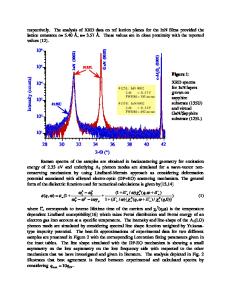Properties of nanostructured diamond-silicon carbide composites sintered by high pressure infiltration technique
- PDF / 130,571 Bytes
- 5 Pages / 612 x 792 pts (letter) Page_size
- 114 Downloads / 474 Views
J. Gubicza Department of Solid State Physics, Eötvös University, Budapest H-1518, Hungary
T. Ungár Department of General Physics, Eötvös University, Budapest H-1518, Hungary
S.N. Dub Institute for Superhard Materials of the NAS of Ukraine, Kiev 02074, Ukraine (Received 11 March 2004; accepted 4 June 2004)
A high-pressure silicon infiltration technique was applied to sinter diamond–SiC composites with different diamond crystal sizes. Composite samples were sintered at pressure 8 GPa and temperature 2170 K. The structure of composites was studied by evaluating x-ray diffraction peak profiles using Fourier coefficients of ab initio theoretical size and strain profiles. The composite samples have pronounced nanocrystalline structure: the volume-weighted mean crystallite size is 41–106 nm for the diamond phase and 17–37 nm for the SiC phase. The decrease of diamond crystal size leads to increased dislocation density in the diamond phase, lowers average crystallite sizes in both phases, decreases composite hardness, and improves fracture toughness.
I. INTRODUCTION
Diamond–silicon carbide composites have recently attracted a lot of attention due to their unique mechanical properties and a great potential for a variety of applications. The following methods of their processing have been reported: infiltration of diamond powders by silicon at high1–4 and normal5,6 pressures, high-pressure sintering of diamond/SiC powder mixtures,7–10 synthesis of diamond/–SiC composite films by microwave plasma assisted chemical vapor deposition.11 To date, only the high-pressure silicon infiltration technique has been reported as a method of a large scale production of diamond–SiC composite inserts for rock drilling and other applications.1,3 Composite inserts made by this method have uniform structure and are extremely hard and thermally stable. However, much room still remains for improvement of their mechanical properties, first of all strength and fracture toughness. This goal requires detailed study of structure and properties of composites as a function of manufacturing parameters. One of the most important factors is the size of the crystals of the
a)
Address all correspondence to this author. e-mail address: [email protected] DOI: 10.1557/JMR.2004.0345 J. Mater. Res., Vol. 19, No. 9, Sep 2004
http://journals.cambridge.org
Downloaded: 13 Mar 2015
initial diamond powder. Uniform bulk composites have been produced by silicon infiltration of diamond powders with crystal size ranging from 15 to 60 m.1,3 In this work, we broadened the range of diamond powder crystal size (from 1 to 60 m) and studied how the size of the diamond grains affects the structure and properties of composites. II. EXPERIMENTAL A. Sample preparation and characterization techniques
All composite samples were made by the highpressure silicon infiltration technique.3,4 Synthetic diamond powders of crystal size 1–2 m, 10–14 m, and 40–60 m from the Institute for Superhard Materials, Kiev, Ukraine, and silicon powder of particle size less than 44 m from
Data Loading...











